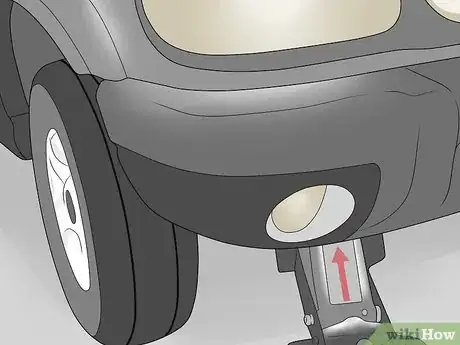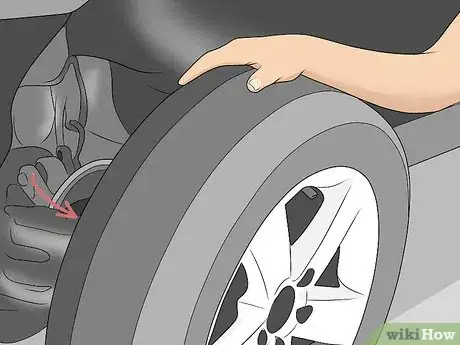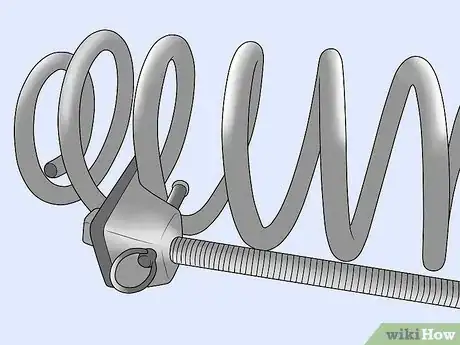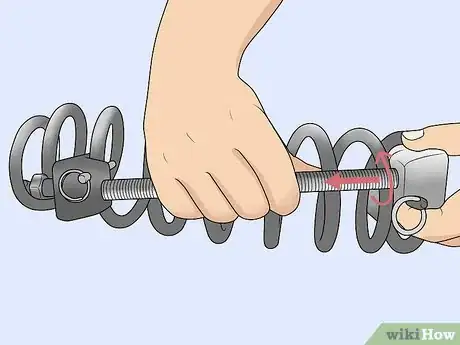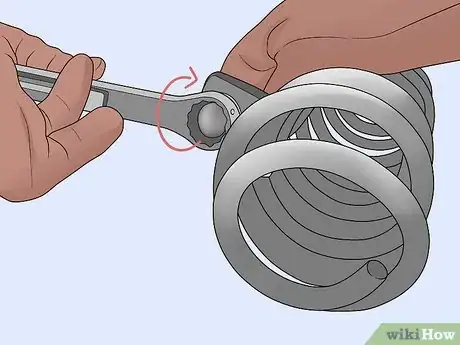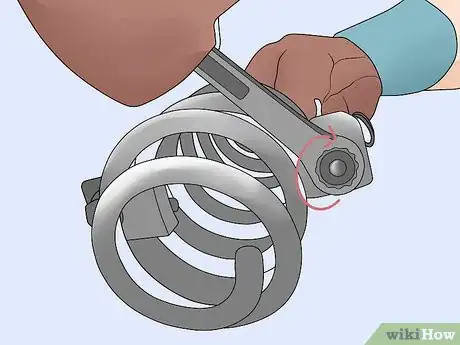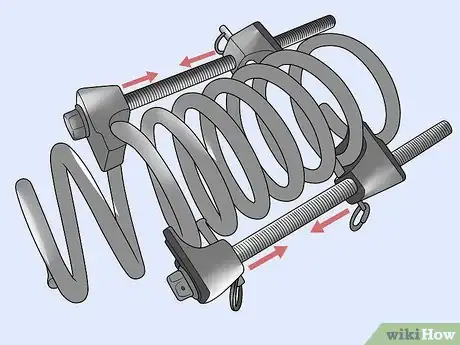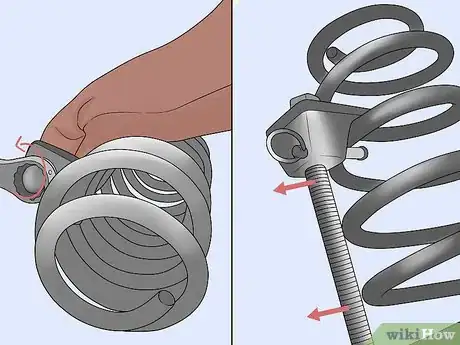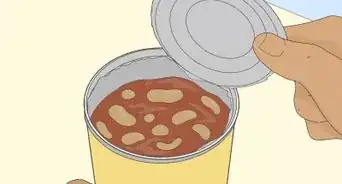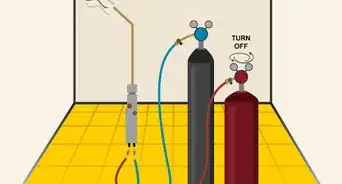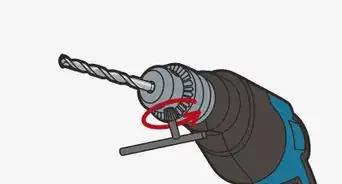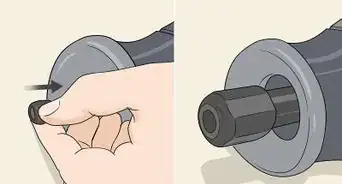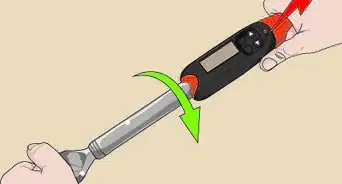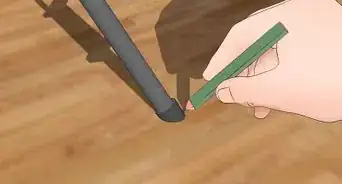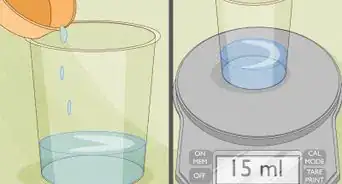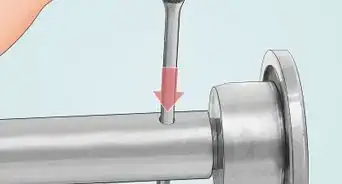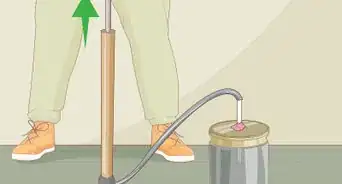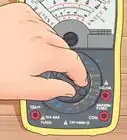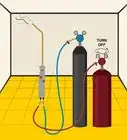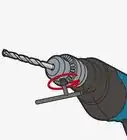This article was co-authored by wikiHow Staff. Our trained team of editors and researchers validate articles for accuracy and comprehensiveness. wikiHow's Content Management Team carefully monitors the work from our editorial staff to ensure that each article is backed by trusted research and meets our high quality standards.
There are 11 references cited in this article, which can be found at the bottom of the page.
This article has been viewed 19,581 times.
Learn more...
Your car's coil springs help absorb impact and keep your car off the ground, making it important for the coils to be compressed so they'll provide the smoothest ride. Compressing a spring is easy to do with the right kit and tools. Attach clamps and safety pins to your spring before using a hand wrench to tighten the nuts at the ends of each rod that comes in a spring compression kit. While springs are compressed different amounts, you'll likely compress it several inches, tightening the spring until the coils are close but not touching. Because a compressed spring is full of energy and potentially dangerous, safety is super important when working with the compressor and spring to make sure you avoid any injuries.
Steps
Attaching the Compressor
-
1Purchase a spring compressor kit to compress the coil correctly. Spring compressor kits come with the tools needed to fully compress a spring, like the rod that will attach to the hooks or clamps, as well as important safety pins that help prevent any injuries. Go online to find a compressor kit that you like, or visit your local auto repair center to see if they'll rent you one.[1]
- Don’t try to compress a spring without the tools that come in a kit.
- Some hardware stores sell spring compressor kits, such as Home Depot, as well as some big box stores.
-
2Jack the car up off of the ground to place a jack stand. Place a jack under the jack point of your car and use the lever to lift the car up so the wheel isn't touching the ground. Put a jack stand under the car near where the jack is supporting the weight, and raise the jack stand so it's holding up the car.[2]
- Your car's jack point will be a flat metal part of your car near the wheels, and it might even be labeled with a symbol or the word "jack."
- Wear safety glasses and protective gloves.
- You can find a car jack and jack stand at your local home improvement store or online.
Advertisement -
3Remove the tire so you can reach the spring. With the car jacked up, use a lug wrench to remove the nuts from the wheel of the car. After each nut is removed, pull the tire off of the car and set it to the side. You can either take the spring off of the car to work on it, or you can compress it while it's still attached to the car.[3]
- You may need to remove additional parts of the car to reach the spring depending on the make and model of your car.
- Remove any parts that are still in your way using a wrench.
- Consult the car's instruction manual for specific directions to help you remove or replace specific parts.
-
4Slide the compressor rod through the end of the clamp. Your kit will come with two rods and four clamp attachments. Pick up a rod and choose one of the two clamps that slides onto the rod easily. Slide the clamp on so that it reaches the bottom of the rod.[4]
- It doesn’t matter which rod you use, as they’re both the same.
- Two clamps are designed to slide right onto the rod, while the other two clamps will be screwed on in later steps.
- If you’ve slid the clamp onto the rod using the open end, the clamp should stay in place at the opposite end because of the bolt.
-
5Attach the clamp to the coil using the safety pin. Once you slide the first clamp to the end of the rod, place the rod against the coil spring so that the clamp is attached to a coil near an end of the spring. Push the safety pin on the clamp so that it stretches across the coil, keeping the clamp in place.[5]
- Placing the clamp on a coil near one end of the spring will help compress as much length as possible.
-
6Twist the other clamp onto the rod before attaching it. Find one of the two clamps that twist onto the end of the rod. Begin twisting the clamp along the threaded rod until you reach a coil. Once the clamp is situated against a coil, use the safety pin to attach the clamp to the spring, just as you did with the first clamp.[6]
- Push the safety pin so that it’s pointing towards the middle of the spring and is touching the coil.
- Make sure the clamp is touching the coil as well, twisting it a bit farther along the rod if necessary.
-
7Repeat the same process to attach the second rod. Place the other rod 180 degrees from the first one so that they’re directly across from each other. Slide a clamp onto the last rod, attaching it to the coil using the safety pin. Twist the last clamp onto the rod and use the safety pin to attach the whole rod firmly to the coil.[7]
- The clamps should be on coils right across from each other so that the coil is compressed evenly.
Tightening the Coil
-
1Use a wrench to tighten the bolts. Fit the wrench around the bolt at the bottom of the coil—this is the bolt that you slid onto the rod. Use the wrench to twist the bolt to the right, tightening it up using small movements of the hand.[8]
- Avoid using power tools when tightening the bolts—this is super dangerous because it puts too much pressure on the rods too quickly.
-
2Switch between sides frequently as you compress the spring. Compressing one side of the spring too much more than the other will put unnecessary pressure on the rod and coil, making it dangerous. Tighten the coil slowly, switching the side you’re tightening every 10-15 twists of the wrench.[9]
- Keep the size of your twists consistent to help compress the spring evenly.
-
3Compress the spring until the coils are close but not touching. When you first started compressing the coil, the threaded clamps will have been near the end of the rods. As you tighten the nuts, the clamps will move up the rod as the coil becomes tighter. Continue tightening until the clamps have moved a good distance along the rod, roughly 3–4 in (7.6–10.2 cm), depending on the length of your spring.[10]
- There is no specific amount the coil needs to be compressed, as this will depend on the type of car you have and how much you want the spring to absorb impact.
- Refer to your car's instruction manual if you have questions about how much to compress your specific coil.
- Avoid compressing the spring so much that the coils touch because this is a dangerous amount of energy.
-
4Disconnect the compressor by loosening the clamps. Once the spring is compressed to your liking, carefully use your wrench to loosen the nut, moving the wrench to the left a few twists. This will loosen the clamps from the coil, making it easy to undo the safety pins and remove the rods from the spring.[11]
- Loosen all four clamps before removing the compressor.
- Loosening the clamps will not affect the spring if done slowly and correctly.
Warnings
- Don't use power tools to speed up the process of tightening the nuts.⧼thumbs_response⧽
- Tighten each side of the coil a little bit at a time to avoid putting too much pressure on one side.⧼thumbs_response⧽
- Be aware that a compressed spring contains a lot of energy, making it dangerous to be around.⧼thumbs_response⧽
- Avoid compressing the spring so much that the coils are touching.⧼thumbs_response⧽
References
- ↑ https://autoquarterly.com/best-strut-compressors/
- ↑ https://www.familyhandyman.com/automotive/tires/car-repair-car-jack-safety/
- ↑ https://www.youtube.com/watch?v=ZRcT-1WIhcI#t=17s
- ↑ https://www.youtube.com/watch?v=wrrtazxg2eg#t=1m7s
- ↑ https://www.youtube.com/watch?v=r60AAKXHa30#t=1m42s
- ↑ https://www.youtube.com/watch?v=wrrtazxg2eg#t=1m26s
- ↑ https://www.youtube.com/watch?v=r60AAKXHa30#t=1m47s
- ↑ https://www.youtube.com/watch?v=wrrtazxg2eg#t=2m44s
- ↑ https://www.youtube.com/watch?v=wrrtazxg2eg#t=2m57s

